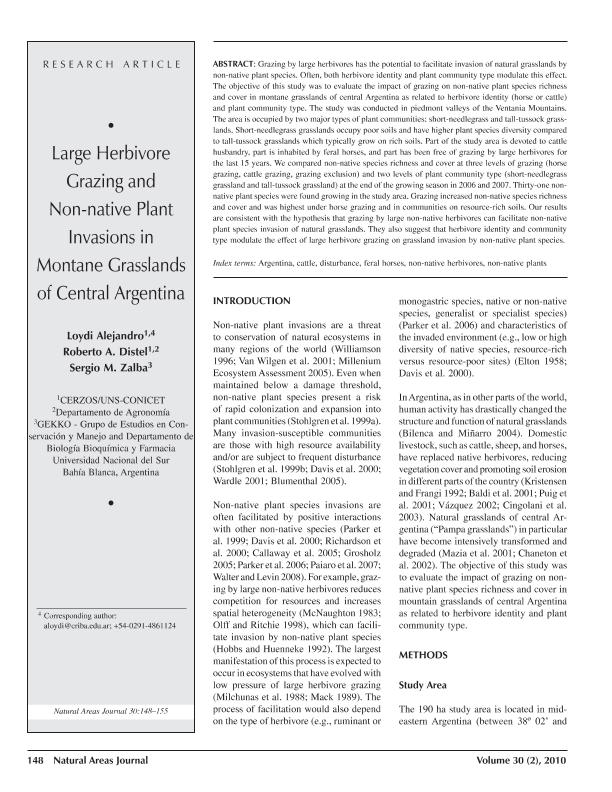Mostrar el registro sencillo del ítem
dc.contributor.author
Loydi, Alejandro

dc.contributor.author
Distel, Roberto Alejandro

dc.contributor.author
Zalba, Sergio Martin

dc.date.available
2017-05-19T15:16:23Z
dc.date.issued
2010-04
dc.identifier.citation
Loydi, Alejandro; Distel, Roberto Alejandro; Zalba, Sergio Martin; Large herbivore grazing and non-native plant invasions in montane grasslands of central Argentina; Natural Areas Assoc; Natural Areas Journal; 30; 2; 4-2010; 148-155
dc.identifier.issn
0885-8608
dc.identifier.uri
http://hdl.handle.net/11336/16719
dc.description.abstract
Grazing by large herbivores has the potential to facilitate invasion of natural grasslands by non-native plant species. It is expected that both herbivore identity and plant community type modulate the effect. The objective of this study was to evaluate the impact of grazing on non-native plant species richness and cover in a montane grassland of central Argentina, as related to herbivore identity (horse or cattle) and plant community type. The study was conducted in piedmont valleys of the Ventania Mountains. The area is occupied by two major types of plant communities: short-needlegrass and tall-tussock grasslands. The former occupies poor soils and has higher plant species diversity compared to the latter which grows on rich soils. Part of the study area is devoted to cattle husbandry, part is inhabited by feral horses, and part has been free of grazing by large herbivores for the last 15 years. We compared non-native richness and percentage cover at three different grazing situations (horse grazing, cattle grazing, grazing exclusion) and at two levels of plant community type (short-needlegrass grassland and tall-tussock grassland) at the end of the growing season in 2006 and 2007. Thirty-one non-native plant species were found growing in the study area. Grazing increased non-native species richness and cover. Invasibility was highest under horse grazing and on communities in resource-rich soils. Our results are consistent with the hypothesis that grazing by large non-native herbivores can facilitate non-native plant species invasion into natural grasslands. They also suggest that herbivore identity and community type modulate the effect of large herbivore grazing on grassland invasion by non-native plant species.
dc.format
application/pdf
dc.language.iso
eng
dc.publisher
Natural Areas Assoc

dc.rights
info:eu-repo/semantics/openAccess
dc.rights.uri
https://creativecommons.org/licenses/by-nc-sa/2.5/ar/
dc.subject
Cattle
dc.subject
Feral Horses
dc.subject
Non-Native Herbivores
dc.subject
Non-Native Plant
dc.subject
Argentina
dc.subject
Disturbance
dc.subject.classification
Ecología

dc.subject.classification
Ciencias Biológicas

dc.subject.classification
CIENCIAS NATURALES Y EXACTAS

dc.title
Large herbivore grazing and non-native plant invasions in montane grasslands of central Argentina
dc.type
info:eu-repo/semantics/article
dc.type
info:ar-repo/semantics/artículo
dc.type
info:eu-repo/semantics/publishedVersion
dc.date.updated
2017-05-10T19:57:20Z
dc.identifier.eissn
2162-4399
dc.journal.volume
30
dc.journal.number
2
dc.journal.pagination
148-155
dc.journal.pais
Estados Unidos

dc.journal.ciudad
Bend
dc.description.fil
Fil: Loydi, Alejandro. Consejo Nacional de Investigaciones Científicas y Técnicas. Centro Científico Tecnológico Conicet - Bahía Blanca. Centro de Recursos Naturales Renovables de la Zona Semiarida. Universidad Nacional del Sur. Centro de Recursos Naturales Renovables de la Zona Semiarida; Argentina
dc.description.fil
Fil: Distel, Roberto Alejandro. Consejo Nacional de Investigaciones Científicas y Técnicas. Centro Científico Tecnológico Conicet - Bahía Blanca. Centro de Recursos Naturales Renovables de la Zona Semiarida. Universidad Nacional del Sur. Centro de Recursos Naturales Renovables de la Zona Semiarida; Argentina
dc.description.fil
Fil: Zalba, Sergio Martin. Universidad Nacional del Sur. Departamento de Biologia, Bioquimica y Farmacia. Grupo de Estudios en Conservacion y Manejo; Argentina
dc.journal.title
Natural Areas Journal

dc.relation.alternativeid
info:eu-repo/semantics/altIdentifier/url/http://www.bioone.org/doi/abs/10.3375/043.030.0203
dc.relation.alternativeid
info:eu-repo/semantics/altIdentifier/doi/http://dx.doi.org/10.3375/043.030.0203
Archivos asociados
